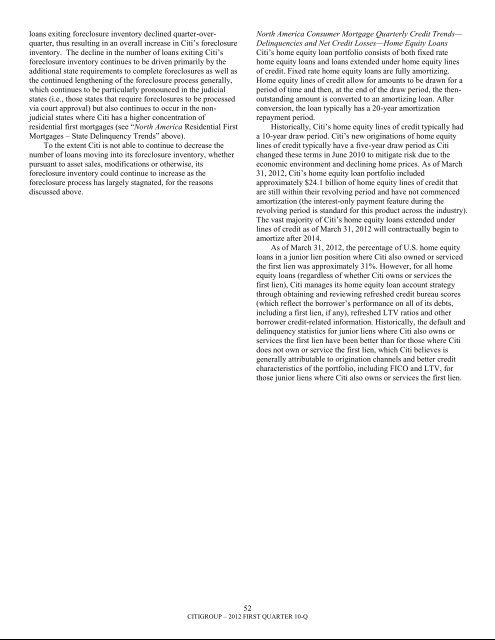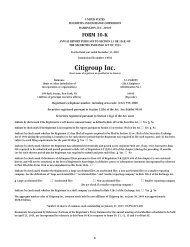Generally, management actions, including asset sales andmodification programs, have continued to be the primary driversof the overall improved asset performance within Citi‘sresidential first mortgage portfolio in Citi Holdings during theperiods presented above (excluding the deferred principal netcredit losses described in note 1 to the tables above). Withrespect to asset sales, Citi sold approximately $0.3 <strong>billion</strong> ofdelinquent residential first mortgages during the first quarter of2012. Regarding modifications, Citi modified approximately$0.2 <strong>billion</strong> of residential first mortgage loans under its HAMPand CSM programs, two of its more significant residential firstmortgage modification programs, in the first quarter of 2012,which represented a slight increase from modification volumesin the fourth quarter of 2011. (For additional information onCiti‘s significant residential first mortgage loan modificationprograms, see ―Consumer Loan Modification Programs‖below.)While re-defaults of previously modified mortgages underthe HAMP and CSM programs continued to track favorablyversus expectations as of March 31, 2012, Citi‘s residential firstmortgage delinquencies and net credit losses continue to showsome signs of the impact of re-defaults of previously modifiedmortgages. This is reflected in the stabilizing to slightlyincreasing delinquency and net credit loss trends in the tablesabove (excluding the deferred principal net credit lossesdescribed in note 1 to the tables above). Moreover, as a result ofthe continued lengthening of the foreclosure process (seediscussion under ―Foreclosures‖ below), 180+ days past duedelinquencies are increasing.Accordingly, Citi continues to believe that its ability tooffset increasing delinquencies or net credit losses in itsresidential first mortgage portfolio, due to any deterioration ofthe underlying credit performance of these loans, re-defaults, thelengthening of the foreclosure process or otherwise, pursuant toasset sales or modifications could be limited going forwardgiven the lack of remaining inventory of loans to sell or modify(or due to lack of market demand for asset sales). Citi has takenthese trends and uncertainties, including the potential for redefaults,into consideration in determining its loan loss reserves.See ―North America Consumer Mortgages – Loan Loss ReserveCoverage‖ below. Citi also continues to believe that anyincrease in net credit losses relating to additional principalforgiveness or deferred principal charge-offs relating to thenational mortgage settlement will be covered by its existing loanloss reserves. See also ―Credit Risk—National MortgageSettlement‖ below.North America Residential First Mortgages— State Delinquency TrendsThe following tables set forth, for total <strong>Citigroup</strong>, the six states and/or regions with the highest concentration of Citi‘s residential firstmortgages as of March 31, 2012 and December 31, 2011.In <strong>billion</strong>s of dollars March 31, 2012 December 31, 2011%90+DPD LTV > RefreshedENR 90+DPD% 100% FICO ENR (2) Distribution %51CITIGROUP – 2012 FIRST QUARTER 10-Q%LTV >100%State (1) ENR (2) ENRDistributionRefreshedFICOCA $ 22.4 28% 2.9% 39% 727 $ 22.6 28% 2.7% 38% 727NY/NJ/CT 11.4 14 4.6 12 715 11.1 14 4.7 9 712IN/OH/MI 4.5 5 5.8 47 652 4.6 6 6.0 44 650FL 4.1 5 9.1 56 671 4.2 5 9.6 56 669IL 3.4 4 6.6 49 688 3.5 4 6.9 45 686AZ/NV 2.2 3 5.6 70 699 2.3 3 5.7 73 698Other 32.9 41 5.6 23 664 33.4 40 5.6 21 663Total $ 80.9 100% 5.0% 31% 690 $ 81.7 100% 5.0% 30% 689(1) Certain of the states are included as part of a region based on Citi‘s view of similar home prices (HPI) within the region.(2) Ending net receivables. Excludes loans in Canada and Puerto Rico, loans guaranteed by U.S. government agencies, loans recorded at fair value and loans subjectto LTSCs. Excludes balances for which FICO or LTV data is unavailable.As evidenced by the table above, Citi‘s residential firstmortgages portfolio is primarily concentrated in California andthe New York/New Jersey/Connecticut region (with New Yorkas the largest of the three states). The 90+ days past duedelinquency rate improved across each of the states and regionsshown in the table, with the exception of California whichshowed a slight increase. As previously disclosed, as asset saleshave slowed, Citi has observed deterioration in the 90+ dayspast due delinquency rates, and this is reflected in the increasein the delinquency rate in California in the first quarter.Combined with the continued lengthening of the foreclosureprocess (see discussion under ―Foreclosures‖ below) in all ofthese states and regions, Citi expects it could experiencedeterioration, or less improvement, in the 90+ days past duedelinquency rate in one or more of these areas in the future.ForeclosuresAs of March 31, 2012, approximately 2.3% of Citi‘s residentialfirst mortgage portfolio was actively in the foreclosure process,which Citi refers to as its ―foreclosure inventory.‖ Thisrepresented a 6% increase in foreclosure inventory quarter-overquarter,and reflected the first increase in Citi‘s foreclosureinventory after several quarters of gradual declines (foradditional information, see ―Managing Global Risk – CreditRisk – Foreclosures‖ in Citi‘s 2011 Annual Report on Form 10-K).Similar to prior quarters, Citi continued to experience fewerresidential first mortgages moving into its foreclosure inventoryduring the first quarter of 2012, primarily as a result of Citi‘scontinued asset sales of delinquent first mortgages, increasedstate requirements for foreclosure filings and Citi‘s continuedefforts to work with borrowers pursuant to its loan modificationprograms, as previously disclosed. However, the number of
loans exiting foreclosure inventory declined quarter-overquarter,thus resulting in an overall increase in Citi‘s foreclosureinventory. The decline in the number of loans exiting Citi‘sforeclosure inventory continues to be driven primarily by theadditional state requirements to complete foreclosures as well asthe continued lengthening of the foreclosure process generally,which continues to be particularly pronounced in the judicialstates (i.e., those states that require foreclosures to be processedvia court approval) but also continues to occur in the nonjudicialstates where Citi has a higher concentration ofresidential first mortgages (see ―North America Residential FirstMortgages – State Delinquency Trends‖ above).To the extent Citi is not able to continue to decrease thenumber of loans moving into its foreclosure inventory, whetherpursuant to asset sales, modifications or otherwise, itsforeclosure inventory could continue to increase as theforeclosure process has largely stagnated, for the reasonsdiscussed above.North America Consumer Mortgage Quarterly Credit Trends—Delinquencies and Net Credit Losses—Home Equity LoansCiti‘s home equity loan portfolio consists of both fixed ratehome equity loans and loans extended under home equity linesof credit. Fixed rate home equity loans are fully amortizing.Home equity lines of credit allow for amounts to be drawn for aperiod of time and then, at the end of the draw period, the thenoutstandingamount is converted to an amortizing loan. Afterconversion, the loan typically has a 20-year amortizationrepayment period.Historically, Citi‘s home equity lines of credit typically hada 10-year draw period. Citi‘s new originations of home equitylines of credit typically have a five-year draw period as Citichanged these terms in June 2010 to mitigate risk due to theeconomic environment and declining home prices. As of March31, 2012, Citi‘s home equity loan portfolio includedapproximately $24.1 <strong>billion</strong> of home equity lines of credit thatare still within their revolving period and have not commencedamortization (the interest-only payment feature during therevolving period is standard for this product across the industry).The vast majority of Citi‘s home equity loans extended underlines of credit as of March 31, 2012 will contractually begin toamortize after 2014.As of March 31, 2012, the percentage of U.S. home equityloans in a junior lien position where Citi also owned or servicedthe first lien was approximately 31%. However, for all homeequity loans (regardless of whether Citi owns or services thefirst lien), Citi manages its home equity loan account strategythrough obtaining and reviewing refreshed credit bureau scores(which reflect the borrower‘s performance on all of its debts,including a first lien, if any), refreshed LTV ratios and otherborrower credit-related information. Historically, the default anddelinquency statistics for junior liens where Citi also owns orservices the first lien have been better than for those where Citidoes not own or service the first lien, which Citi believes isgenerally attributable to origination channels and better creditcharacteristics of the portfolio, including FICO and LTV, forthose junior liens where Citi also owns or services the first lien.52CITIGROUP – 2012 FIRST QUARTER 10-Q
















